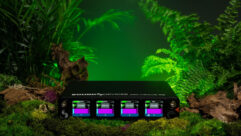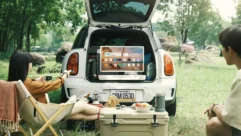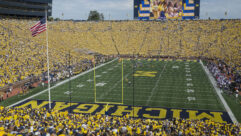

DTV: Hold on Tight, Here We go
As you read this, the terrestrial digital TV “transition” (or more accurately, the analog TV shutdown) is just around the corner. Are we ready? Will the days before the big switch be full of dire predications, a la Y2K? Or will we just experience a slight bump in the road at midnight?
Pete Putman, CTS
Odds are, there will still be a bunch of problems to deal with. For one thing, that endearing human trait known as procrastination will surely result in a tidal wave of phone calls to local TV stations after the switch, demanding to know where their analog signal went while denying any knowledge of the shutdown. (This, even though we’ve been bombarded with public service announcements on TV, ads in papers and magazines, and test shutdowns of analog broadcasts in almost every major market since last summer.)
For another thing, there are numerous TV stations waiting for the current occupant of their assigned DTV channel to pack up and move out, so the former group can light up their transmitters. In some cases, that “current occupant” is using a temporary DTV channel assignment. In others, it’s an existing analog TV station that’s been there for years.
The TV stations nestled on channels 52 through 69 have another problem altogether: They’re considered squatters after February 17, and are being evicted to channels 2 through 51. Some of these folks have the misfortune of not only operating a legacy analog TV station in these “outside the core” channels, but also got a temporary DTV channel assignment from the FCC in the same block.
How about things at the receiving end? It wasn’t that long ago that major consumer electronics manufacturers openly scoffed at the idea of a $50 terrestrial DTV converter box. Who’d buy it?
Well, as of now, there are more than 60 models of converter boxes offered for sale, with 44 of them capable of passing through analog (NTSC) TV signals. About 40 million DTV converter box coupons had been requested, with more than 16 million redeemed, according to the Commerce Department’s National Telecommunications and Information Administration (NTIA). That’s a lot of converter boxes! (The NTIA even had to start putting people on a wait list for coupons, prompting Barack Obama and the Consumers Union to request a delay in the transition.)
Analog TV pass-through? Yep, it seems the FCC overlooked one small detail in the conversion to digital TV: Although full-power TV stations must go digital on February 17, low-power stations and translators are exempt for now. The only problem with that action was that early models of DTV converter boxes largely ignored analog signal pass-through, prompting a lawsuit against the FCC by the trade association for low power broadcasters, the Community Broadcasters Association (CBA).
No Reason Not to Have It
Because digital TV is so much better in quality and more versatile than analog TV, interest in receiving it is steadily growing. Sales of antennas have started climbing as more and more people realize they can get free digital TV (including some nice HDTV programming) by adding rabbit ears to their new HDTV set, or an attic or rooftop antenna.
DTV: Hold on Tight, Here We go
That interest has even filtered into our market, where AV integrators are being asked to incorporate terrestrial digital TV reception into retrofit or new installs, and some manufacturers have introduced RS-232-controllable ATSC tuners. The idea is that local news, weather, and other information would be available free of charge (and of course, it doesn’t hurt that the Super Bowl or World Series might be fun to watch in a boardroom).
Seriously, though: It’s an excellent idea to have access to local DTV stations for emergency preparedness reasons, if no other. Tornadoes, hurricanes, earthquakes, fires, and other natural disasters can disrupt cable or satellite TV services (the “one serving many” model), but it’s unlikely that every TV station would be forced off the air during such events (the “many serving one” model).
Another market that is interested in adding terrestrial DTV reception is education. Most Public Broadcasting System (PBS) affiliates multicast three or four channels of specialty programming during all but primetime hours, focusing in on programming for kids, politics, science, health, and do-it-yourself topics.
There are also proposals to add an overlay mobile digital TV service, although there’s no indication at present whether this would succeed. A mobile DTV standard is being considered for adoption by the ATSC and would involve willing broadcasters setting aside some of their bandwidth for these channels, which would use MPEG4 encoding exclusively and low-resolution video.
Last-Minute Training
At the TV station level, there’s a lot of last-minute training going on. Control room personnel now not only have to check the “on air” monitor from time to time to verify there’s actually a signal, but they also need to monitor (among other things) MPEG program streams and numbers, ancillary data (PSIP), audio formats (mono, stereo, Dolby Digital 5.1), audio levels (dialnorm), and captions (converted EIA608 captions and EIA708 digital captions).
How about HDTV reception? A.C. Nielsen announced on November 30, 2008 that HDTV penetration had reached 23.3 percent of all U.S. households. That’s more than double the number that Nielsen announced in July 2007, when it started installing new People Meters that measure HDTV viewing.
Admittedly, many of those households are watching only cable or satellite HD channels. But every TV sold after July 2007 (even VCRs and DVD recorders with analog tuners) must include a terrestrial digital TV tuner, so there’s potentially a much larger audience for ATSC broadcasts than even those tuned in via NTIA converter boxes.
Way back in 1997, when the DTV transition first got off the ground, it was hard to imagine that digital TV would become such a mainstream service. Early set-top boxes were bulky, unstable, and overheated frequently. Signals were difficult to pull in when received in less-than-perfect environments, and HDTV sets largely used CRT technology, weighed a ton, and required component video connections.
Today, NTIA converter boxes handle multipath with ease. The CRT has largely vanished from store shelves; LCD and plasma HDTVs with 720p and 1080p resolution are going for dirt cheap prices, and customers are now clamoring for digital video recorders (DVRs) to go with their viewing. HDTV is mainstream for local news, sports, talk shows, and prime time programming.
Like it or not, digital is the future of broadcast television. And ready or not, here it comes.
InfoComm Educator of the Year Pete Putman is a PRO AV contributing editor and president of ROAM Consulting in Doylestown, Pa.










